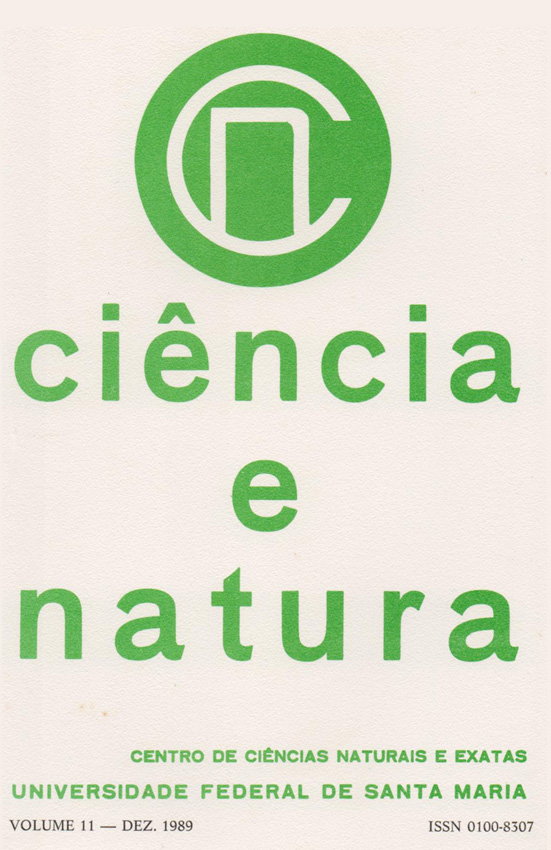Determinação da produção de madeira Acácia negra, Acacia Mearnsii de Wild
DOI:
https://doi.org/10.5902/2179460X25553Resumo
O presente trabalho foi desenvolvido com acácia negra, Acacia mearnsii De Wild e teve como objetivo a elaboração de tabelas de produção de madeira, com e sem casca estimadas através de equações obtidas por modelagem da produção em função da idade, altura dominante e área basal, expressa pelo modelo genérico: log V = bo+bl.ho2+b2.logG, sendo V o volume por hectares; G a área basal por hectare, ho a altura dominante. Esta equação apresentou uma alta precisão estatística, sendo que as variáveis independentes, altura dominante e área basal, explicaram 97,8% e 85,2% da variação da produção com e sem casca, respectivamente.
Downloads
Referências
ALDER, D. Forest volume estimation and Yield prediction. Roma, FAO., 1980. v.2.194p.
BENETT, F.A.; Mc-GEE, C.E. & CLUTTER, J.L. Yield of old field Slash pine plantations. U.S. Depart. of Agriculture. Southeastern Forest Experiment Station Paper nº 107. 1959. 19p.
CLUTER, J. L. Compatible growth and models for loblolyy pine. For.Sci., 9(3):355-371,1963.
DE HOOGH, R.Y.; DITRICH, A.; AHRENS, S. Classificação de sitio, tabela de volume e produção para povoamento de Araucaria angustifolia. Brasil Florestal, 9(36):58-82, 1978.
HEINSDIJK. D. & SOARES, R.D. Plantações de coniferas no Brasil. Estudos preliminares sobre volumes e rendimentos de Araucaria angustifolia, Cryptomeria japonica, Cunninghamia lanceolata e Pinus elliottii. Ministerio da Agricultura Div. de Silv., 1962. 75p. (Bol.5).
HRADETZKY, J. Modell eines integrierten Ertragstafel-Systems in modular Form. Mitteilungen der Forstlichen Versuchs und Forschungsanstalt Baden-Württemberg, Abteilung Biometrie. 11(45): 15p. 1972.
HUSCH, B. Forest mensuration and statistics. New York, Ronald Press, 1963. 474p.
KENNEL, R. Die Bestimmung des Ertragsniveaus bei der Buche. Hamburg, Forstw.Cbl. 92:226-234. 1973.
MINISTERIO DA AGRICULTURA. Distrito Florestal. Secretaria da Agricultura e Instituto-Brasileiro de Desenvolvimento Florestal, 1960. 210p.
MITSHERLICH, G. & SONNTAG, G. Papelversuche: modell für line Resenertrag und Neupotz-Pappel-Ertragstafel im Oberheisgebiet, Allg. Forst und Jg. 153(12) :213-219. 1982.
MORENO, J.A. Clima do Rio Grande do Sul. Porto Alegre, Secretaria da Agricultura-RS, 1961. 41p.
PIO CORREA, M. Dicionário das plantas úteis do Brasil e das exóticas cultivadas. Rio de Janeiro, Imprensa Nacional, 1926. v1. 747p.
SCHNEIDER, P.R. Betriebswirtschaftliche und ertragskundliche grundlagen der Forsteinrichtung in südbrasilen am Beispiel von Pinus elliottii. Freiburg, Albert-Ludwigs-Universitat, 1984. 192p. (Tese de Doutorado).
SCHNEIDER, P.R. & HOSOKAWA, R. T. Estudo de equações volumétricas para tabelas de volume com e sem casca para Acácia negra (Acacia mearnsii de Wild). In: Congresso Florestal Brasileiro, 3, Manaus, 1978. anais ... Silvicultura 14:90-95, 1979.
SCHNEIDER, P.R. & SILVA, J.A. da. Índice de sitio para acácia negra, Acacia mearnsii de•Wild. Brasil Florestal, 36: 58-82, 1980.
SHERRY, S.P. The Black Wattle (Acacia mearnsii). Pietermoritzburg, University of Natal Press, 1971. 402p.
SCHÖNAU, A.P.G. A site evaluation Study in Black Watlle (Acacia mearnsii de Wild.). Ann. Univ. Von Stellenbosch, 44(2A):214p. 1969.
Downloads
Publicado
Como Citar
Edição
Seção
Licença
Para acessar a DECLARAÇÃO DE ORIGINALIDADE E EXCLUSIVIDADE E CESSÃO DE DIREITOS AUTORAIS clique aqui.
Diretrizes Éticas para Publicação de Revistas
A revista Ciência e Natura está empenhada em garantir a ética na publicação e na qualidade dos artigos.
A conformidade com padrões de comportamento ético é, portanto, esperada de todas as partes envolvidas: Autores, Editores e Revisores.
Em particular,
Autores: Os Autores devem apresentar uma discussão objetiva sobre a importância do trabalho de pesquisa, bem como detalhes e referências suficientes para permitir que outros reproduzam as experiências. Declarações fraudulentas ou intencionalmente incorretas constituem comportamento antiético e são inaceitáveis. Artigos de Revisão também devem ser objetivos, abrangentes e relatos precisos do estado da arte. Os Autores devem assegurar que seu trabalho é uma obra totalmente original, e se o trabalho e / ou palavras de outros têm sido utilizadas, isso tem sido devidamente reconhecido. O plágio em todas as suas formas constitui um comportamento publicitário não ético e é inaceitável. Submeter o mesmo manuscrito a mais de um jornal simultaneamente constitui um comportamento publicitário não ético e é inaceitável. Os Autores não devem submeter artigos que descrevam essencialmente a mesma pesquisa a mais de uma revista. O Autor correspondente deve garantir que haja um consenso total de todos os Co-autores na aprovação da versão final do artigo e sua submissão para publicação.
Editores: Os Editores devem avaliar manuscritos exclusivamente com base no seu mérito acadêmico. Um Editor não deve usar informações não publicadas na própria pesquisa do Editor sem o consentimento expresso por escrito do Autor. Os Editores devem tomar medidas de resposta razoável quando tiverem sido apresentadas queixas éticas relativas a um manuscrito submetido ou publicado.
Revisores: Todos os manuscritos recebidos para revisão devem ser tratados como documentos confidenciais. As informações ou ideias privilegiadas obtidas através da análise por pares devem ser mantidas confidenciais e não utilizadas para vantagens pessoais. As revisões devem ser conduzidas objetivamente e as observações devem ser formuladas claramente com argumentos de apoio, de modo que os Autores possam usá-los para melhorar o artigo. Qualquer Revisor selecionado que se sinta desqualificado para rever a pesquisa relatada em um manuscrito ou sabe que sua rápida revisão será impossível deve notificar o Editor e desculpar-se do processo de revisão. Os Revisores não devem considerar manuscritos nos quais tenham conflitos de interesse resultantes de relacionamentos ou conexões competitivas, colaborativas ou outras conexões com qualquer dos autores, empresas ou instituições conectadas aos documentos.






